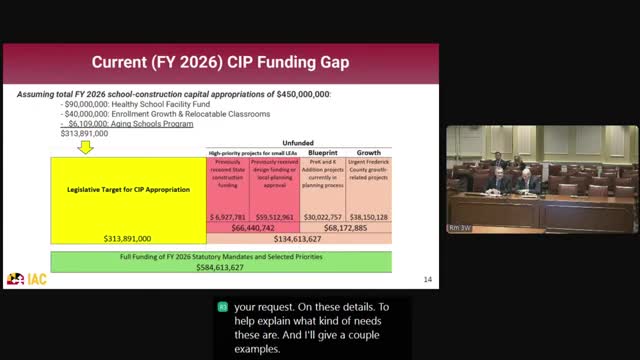County struggles to fund $30 million school project amid rising costs and budget pressures
January 15, 2025 | Budget and Taxation Committee, SENATE, SENATE, Committees, Legislative, Maryland
This article was created by AI summarizing key points discussed. AI makes mistakes, so for full details and context, please refer to the video of the full meeting. Please report any errors so we can fix them. Report an error »

In a recent meeting of the B&T Committee in Maryland, significant discussions emerged regarding the challenges faced by local jurisdictions in funding large school projects. The meeting highlighted the struggles of a particular county that lacks both the annual state allocation and the local capital borrowing power necessary to finance a major construction project within the typical three-year timeline.
The Interagency Commission on School Construction (IAC) is stepping in to assist, offering a high percentage of project costs. However, the reimbursement process may extend over five to seven years, creating a financial strain for the county. Local jurisdictions are often under the impression that once a project is approved, funding is guaranteed. This misconception poses a challenge, as the IAC cannot assure funding due to uncertainties in the state budget and legislative decisions.
A key issue discussed was the county's requirement to provide a $30 million match, which represents a mere 5% of the total project cost. The county currently lacks the funds to meet this obligation, complicating their ability to move forward. The committee explored temporary solutions, such as local borrowing to pre-fund the state’s share or deferring projects. However, the planning and execution of these projects require careful coordination to avoid delays and incomplete constructions.
The meeting underscored the increasing pressures on school districts, which are now facing heightened fiscal constraints. Many districts report feeling cornered, with limited short-term options to keep urgent projects on track. The rising costs and budgetary pressures have made it more difficult for jurisdictions to manage their construction needs effectively.
As the IAC continues to evaluate project requests, the committee emphasized the importance of timely funding and support to prevent disruptions in construction. The discussions reflect a growing concern about the sustainability of school infrastructure projects in the face of escalating demands and financial limitations. Moving forward, the committee will need to address these challenges to ensure that essential educational facilities can be developed and maintained.
The Interagency Commission on School Construction (IAC) is stepping in to assist, offering a high percentage of project costs. However, the reimbursement process may extend over five to seven years, creating a financial strain for the county. Local jurisdictions are often under the impression that once a project is approved, funding is guaranteed. This misconception poses a challenge, as the IAC cannot assure funding due to uncertainties in the state budget and legislative decisions.
A key issue discussed was the county's requirement to provide a $30 million match, which represents a mere 5% of the total project cost. The county currently lacks the funds to meet this obligation, complicating their ability to move forward. The committee explored temporary solutions, such as local borrowing to pre-fund the state’s share or deferring projects. However, the planning and execution of these projects require careful coordination to avoid delays and incomplete constructions.
The meeting underscored the increasing pressures on school districts, which are now facing heightened fiscal constraints. Many districts report feeling cornered, with limited short-term options to keep urgent projects on track. The rising costs and budgetary pressures have made it more difficult for jurisdictions to manage their construction needs effectively.
As the IAC continues to evaluate project requests, the committee emphasized the importance of timely funding and support to prevent disruptions in construction. The discussions reflect a growing concern about the sustainability of school infrastructure projects in the face of escalating demands and financial limitations. Moving forward, the committee will need to address these challenges to ensure that essential educational facilities can be developed and maintained.
View full meeting
This article is based on a recent meeting—watch the full video and explore the complete transcript for deeper insights into the discussion.
View full meeting
